Canonsburg’s prosperity arrived
by railroad
by James T. Herron, Jr.
N.B. References and annotations are
found in the appropriate places in the text, but colored
green.
In its earliest days, Canonsburg was a stagecoach stop on the
road between Pittsburgh and Washington. Before the 1820s, the traffic
from Pittsburgh came in behind Morganza (Western State), across Brush
Run on Cecil Street, along Pitt Street (in early times, Pittsburgh
Street), down the steep North Central Avenue hill, then right on what
is now Pike Street. About 1820, the Washington and Pittsburgh
Turnpike was constructed to connect Pittsburgh with the National Road
at Washington. The easiest route was to follow Chartiers Creek, so
Canonsburg continued to be on a major artery of transportation.
Unfortunately for Canonsburg and for the turnpike’s stockholders,
the procession of freight wagons between Washington and Pittsburgh
did not materialize. Packet boats on the Monongahela River carried
goods between Brownsville and Pittsburgh much more cheaply and
quickly than wagons transporting the freight by road. Consequently,
the turnpike was a failure and eventually was taken over by the
political entities through which it passed.
Steps were taken in 1830 to compete with the riverboats by
building a railroad. This was just two years after the Baltimore and
Ohio laid its first rails, and there were but four railroads in the
world, three of them in England. In 1831, the B&O’s right-of-way
extended just 23 miles. At a meeting held in Washington, Pa. in
December 1830, resolutions were passed to construct a railroad from
the National Road at Washington to the Pittsburgh terminus of the
Pennsylvania Canal. The route would be along Chartiers Creek, which
meant it would pass through or adjacent to Canonsburg, depending on
which side of the creek the rails were laid.
The route, along
Chartiers creek from Washington to the Ohio River, then up the river
to the south end of the Monongahela Bridge, was surveyed by Charles
De Hass in February and March 1830. In his report, the engineer
described the proposed route and detailed the culverts, bridges, and
grading that would be necessary, as well as an estimate of costs.
Since there was little to base his costs on, De Hass used data from
the Baltimore and Ohio and the Pennsylvania Canal. As an
example of how early this was in the history of railroads, three
methods of laying track were proposed: "the first is constructed of
stone sills and iron rails; the second with stone blocks, wood string
pieces and iron rails, and the third with wooden sleepers and string
pieces and iron rails."
- "The Chartiers Railway" and
"Engineer’s Report," Washington Reporter, May 17, 1871. The Reporter reprinted the engineer’s 1830 report in full when
the railroad was completed 41 years later.
A company was formed and incorporated by the state
legislature in March 1831 as the Washington and Pittsburgh Railroad
Company. The construction of a railroad was opposed by many, and
particularly by the freight haulers. Others based their opposition on
more complex economics: fewer horses would be needed, which would
reduce the market for hay and oats, and that would directly affect
the purses of the local farmers. The railroad stock sold poorly, and
the charter had to be forfeited. A few years later, in 1837, another
Washington and Pittsburgh Railroad Company was incorporated, but it
soon withered away, as did a subsequent effort in 1846.
An 1853 revival of the railroad scheme was somewhat more
successful. The name was changed to the Chartiers Valley Railroad
Company and the legislature granted a charter on February 7. This
time all the stock was subscribed (though not paid for). Grading
began and the railroad’s chief engineer reported in 1857 that the
roadbed would be completed by the following year, though this did not
include building bridges or finishing the roadbed so that track could
be laid. More than $162,000 had been expended and another $88,000
would be needed to complete the grading. Track, bridges, and other
necessities would require another quarter of a million dollars.
The Panic of 1857 put an end to the Chartiers Valley Railroad
Company. The Washington Reporter remarked that "popular
excitement on the subject abated." Construction on the railroad, by
then heavily mortgaged, was stopped. Nothing was done until after the
Civil War. In October 1865, the assets of the Chartiers Valley
Railroad were advertised for sale. Lawsuits concerning the order
creditors would be paid delayed the sale until October 1866. The
buyer of record was W. J. Howard, solicitor for the Pennsylvania
Railroad. The assets of the Chartiers Valley Railroad were conveyed
to the Pennsylvania Railroad for just $45,100. This was a bargain,
but it was the right-of-way from Pittsburgh to Mansfield (now known
as Carnegie), not the partially completed railroad to Washington,
that the Pennsylvania Railroad wanted.
- Earle R. Forrest,
History of Washington
County Pennsylvania
(Chicago, 1926), I, 786-790; "The Chartiers Railway,"
Reporter May 17, 1871.
- Figure 1, right. When this 1843
advertisement ran in the Washington Reporter, the
railroad was still very far away.
- Figure 2, below. Map showing
the area railroads from Caldwell’s Atlas of Washington
County, published in 1876.
|

|
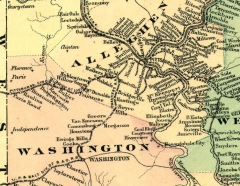
|
For generations, Canonsburg had depended upon Jefferson College
for much of its income. As far as the town was concerned, probably
the most important commodity that had been carried on the turnpike
was passengers. Then, in 1868, the college was moved to Washington.
Academy boys replaced the college students, but they were inferior
both in numbers and cash inflow. The "forts," as the college rooming
and boarding houses were known, were no longer needed. It would not
be long before the town, once so vital and renowned, would also
become derelict. Canonsburg had a decrease in population from 1860 to
1870 (650 to 641 respectively). It wasn’t a large loss, but it was
cause for concern since the adjacent townships all gained. However,
the town would be rescued by the railroad that had repeatedly failed.
- "Census Returns,"
Reporter, Aug. 31, 1870.
The Pennsylvania Railroad built its gateway to the West, the
Pittsburgh, Cincinnati & St. Louis Railway, to Steubenville,
departing Pittsburgh on the right-of-way acquired with the Chartiers
Valley Railroad. Because it crossed the Panhandle of West Virginia,
the P.C.& St.L. was known as the "Pan-Handle Division." The
railroad was in no hurry to build a branch to Washington, but the
local people took action. At a series of meetings in the spring and
summer of 1869, money was raised to induce the railroad to build the
branch from Mansfield to Washington. The price the Pennsylvania
Railroad demanded was steep, but subscriptions for the required
$250,000 in stock were secured and work began on what continued to be
known as the Chartiers Valley Railway or the Chartiers Branch.
Though encouraging people to subscribe for the stock and getting
their money were two very different propositions, the Pennsylvania
Railroad began construction from Mansfield (Carnegie) toward
Washington. As the roadway was constructed, trains were run to the
end of the line, allowing the railroad to collect fares and freight
charges while work was proceeding.
- Forrest, Hist. Wash. Co., 791; "The Chartiers Railway,"
Reporter May 17, 1871; ; "The Chartiers Valley
Railroad," Reporter Oct. 12, 1870; "Best Paying Road in All the
World," Canonsburg Notes,
Dec. 1, 1902. The Washington Reporter noted that the Pan-Handle was double tracked most
of the way between Pittsburgh and Steubenville ("The Pan Handle
Railroad," Reporter, June 1, 1870). In reference to the
railroad,
Pan-Handle will
be spelled with a hyphen, the way the Pennsylvania Railroad
spelled it on its timetables.
In mid-August 1870, the Washington newspaper carried a request
from the railroad to stockholders, asking that they pay their
subscriptions. A spokesman for the Pennsylvania Railroad advised,
"The work of grading and bridging will be completed to Canonsburg in
two weeks." He said that track construction would proceed at an
average of nearly two miles a week "until the whole is completed to
Washington."
It seems that the railroad officials were whistling in the dark.
Apparently, they did not have clear title to the right-of-way near
Washington. In October 1870, Pennsylvania Railroad officials made an
inspection trip on a special out of Pittsburgh to Mansfield and then
to the end of the line. The finished part of the Chartiers Valley
right-of-way extended only six miles, to near Jarrett’s Tavern, a
stage coach stop on the Washington & Pittsburgh Turnpike.
However, the roadbed was finished all the way to Canonsburg, and the
railroad was sticking to its prediction of laying a quarter-mile of
track a day. The railroad said it expected to complete the branch all
the way to Washington by the first of January, but that delays in
subscribers paying up would delay completion.
An article in the Pittsburgh Commercial, influenced
if not written by the railroad, described the Chartiers Valley branch
as "the best constructed branch road which the Pennsylvania Company
has." However, the track was laid before the Pennsylvania Railroad
standardized its gauge. In 1878 the railroad announced that the rails
would be adjusted to the gauge used throughout the system. An item in
the newspaper states that the gauge being two-thirds of an inch wider
than standard had required the use of "compromise trucks" on the
Chartiers. (Trucks are the wheel assemblies under railroad cars.)
- "Chartiers Railway,"
Reporter, Aug 17, 1870; "The Chartiers Valley
Railroad (reprint from the Pittsburgh Commercial)," Reporter, Oct. 12, 1870, "Change of Gauge," Canonsburg
Herald, Jan. 18, 1878.
Diarist T. Maxwell Potts recorded on December 3, 1870, "The
railroad is now finished to within two miles of Canonsburg—to the
toll gate on the turnpike." On the fifteenth he wrote that he had
walked down to where they were laying track, "just below where it
crosses the turnpike." Redevelopment has changed East Pike Street so
that it and the railroad no longer intersect, but at one time the
grade crossing on East Pike Street was just east of Ashland Avenue.
At the time, Potts had a hardware store and a print shop. On
December 16, the conductor on the Chartiers Railway (probably Charles
W. Paisley) ordered some 500 timetables. The first livestock shipment
from the Canonsburg area had been made on the eighth, and passenger
service to and from Canonsburg was scheduled to begin December 19,
1870.
- T. M. Potts Diary, Dec. 3, 15,
and 17, 1870;
"Chartiers Valley
Railroad," Reporter, Dec. 14, 1870. The
conductor, not the engineer, was in charge of a train. Charles
Paisley had been an engineer, as is evident from an 1874 item in
the Herald
related to a strike by the engineers. "Mr. Paisley, the conductor,
mounted the engine himself, in consequence of which the passenger
train has not missed a single trip. Charlie makes a very fair
engineer ("Acting Engineer," Herald,
Jan. 2, 1874)."
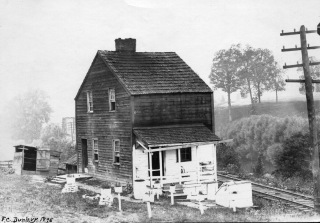
|
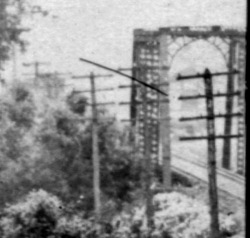
|
|
Figure 3. Left, an 1895 photograph by
Force Dunlevy of the railroad bridge at Morganza behind
the house that was supposed to have been a tollhouse on
the turnpike, apparently the one Maxwell Potts mentioned
in his diary. The picture was taken from Murray Hill,
towards Canonsburg. Morganza would have been in the
background to the right. Above, an enlargement of part of
the photograph showing the original bridge before
double-tracking.
|
Four trains were scheduled each day between Canonsburg and
Pittsburgh, one each way in the morning and again in the afternoon.
Actually, one locomotive and a train of mixed freight and passenger
cars could, and probably did, make all four 14-mile trips between
Canonsburg and Mansfield. The railroad between Mansfield and
Pittsburgh had not yet been double-tracked, so passengers rode P.C.
& St. L. cars between Mansfield and Pittsburgh.
In spite of what had been said, the railroad suspended
construction during the winter weather. The building of the depot at
Washington continued, though, and the Washington newspaper reported
that preparations were underway to build a freight depot, water tank,
and turntable.
Maxwell Potts recorded in his diary on April 11, 1871 that
service on the railroad had been extended to Ewing’s (Meadowlands).
The Washington newspaper confirmed that trains would run to Ewing’s
until the branch was finished and that "the line of hacks will convey
passengers to and from that point," the three miles between there and
Washington.
- "Chartiers Valley Railroad,"
Reporter, Feb. 1, 1871; "The Depot Building,"
Reporter, Mar. 29, 1871; T. M. Potts
Diary, Apr. 11, 1871; "Chartiers Railroad,"
Reporter, Apr. 2 and 12, 1871.
May 18 was set as the day the railroad would begin service from
Mansfield all the way to Washington. The day began early, at 6:30
a.m. when the first scheduled train departed the Washington depot
carrying "borough authorities, the committee of arrangement and
reception, as well as Rankin’s Cornet Band and a number of …prominent
citizens who had been invited to join the excursion." They traveled
to Mansfield to await the special from Pittsburgh, which didn’t
arrive until 10:45.
The Reporter said that the special from Pittsburgh had 12
coaches pulled by two locomotives. Aboard were a large number of
dignitaries, including the mayors of Pittsburgh and Allegheny. "After
[the various dignitaries exchanged] hearty congratulations the
whistle was again sounded and the immense train was soon set in
motion up the valley of the Chartiers."
There were well-wishers at the stations along the way and a large
crowd at Canonsburg. Many crowded aboard the train for the final leg
of the trip. The train arrived in Washington shortly before one
o’clock. Then, led by Pittsburgh’s Great Western Band, the crowd
marched to the Town Hall for another round of speeches. They crowded
back on the train at 4 o’clock for a return trip that was
accomplished without incident.
The Washington Reporter editor pronounced the day "a grand
success," though he admitted that another commitment prevented his
taking part in the festivities. Canonsburg gadfly T. Maxwell Potts
would not have missed out on the excitement. He wrote in his diary,
"An excursion train came out from Pittsburgh to Washington having 13
coaches and about 1,000 passengers aboard besides a large number that
went up on the regular train."
- "Chartiers Railway,"
Reporter, May 24, 1871; T. M. Potts
Diary, May 18, 1871. Besides missing the
inaugural run, the Reporter’s editor neglected to set a new timetable. The
"Railroad Directory" in the May 24 issue lists the southern
terminus as Canonsburg. This was corrected the following
week.
The Chartiers Valley locomotive and cars spent the night at
Washington. According to the timetable published on May 31, 1871, the
first train left Washington at 6:20, arrived at Canonsburg at 6:48,
and at Pittsburgh at 8:20, a two-hour trip. The return trip was
slightly faster, leaving Pittsburgh at 8:25, getting to Canonsburg at
9:51, and arriving at Washington at 10:20. The afternoon train left
Washington at 1:35 carrying both passengers and freight.
Consequently, it was slower and did not arrive at the Pittsburgh
depot until 4:00. An extra ten minutes were allowed before the return
trip, scheduled to leave at 4:15. It took nearly two hours to get to
Canonsburg and the schedule allowed more than half an hour to go on
to Washington. The same train crew handled all four trips, and they
did not end their day until the equipment was put away for the night.
This would make their day’s work about thirteen hours, probably
longer.
- "Railroad Directory,"
Reporter, May 31, 1871; "Long Service as Railway
Agent," Notes,
April 18, 1919. The newspaper does not specify whether the times
given are local time or Columbus time, but before the adoption of
Standard Time, the difference was just 12 minutes.
For the first few years, there was regular Sunday service on the
railroad, but in March 1878 a rule went into effect that the only
freight trains that would operate on Sundays on the Pittsburgh,
Cincinnati & St. Louis Railroad (of which the Chartiers Valley
branch was a part) would be those hauling livestock or perishables.
The Canonsburg Herald reported that this meant there would
only be two or three freight trains through town rather than the
usual 20 or more. The newspaper remarked that the train crews had
welcomed the new rule.
- "A New Rule on the
Pan-Handle," Herald,
March 21, 1878.
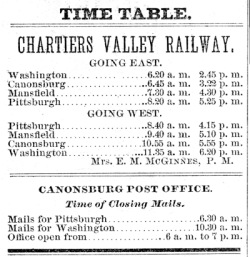
|

|
|
Figure 4, the time table, above, is
from the Canonsburg Herald of August 23, 1872. Figure 4a,
right is one from the Rural Notes, December 4,
1879.
|
By the following year, the schedule was changed to allow more
time at Pittsburgh (see figure 4b). The morning train went much as
before, but the afternoon schedule would have required additional
equipment. The afternoon trip from Washington was scheduled to leave
Washington at 2:35 and arrive at Pittsburgh at 5:25, while the
afternoon trip south left Pittsburgh more than an hour before, at
4:15.
- "Time Table," Herald, Aug. 23, 1872. Whether local or Columbus time is
not specified.
In July 1873 the schedule again was changed making a second
train for passenger operations unnecessary. Apparently the freight
business had gotten to the point that a freight train was added to
the roster, allowing the afternoon mixed train to be a passenger
train. The day was begun earlier, at 6:00 a.m. The train made
Canonsburg at 6:26, Mansfield at 7:15, and Pittsburgh at 7:56. The
train left Pittsburgh at 8:35 for the return trip. The afternoon trip
began earlier, leaving Washington at 1:45 and arriving at Pittsburgh
at 3:39. The earlier start and there being no need to allow for
loading and unloading freight allowed plenty of time before the
return trip, which left Pittsburgh at 4:48.
- "Time Table" and "Chartiers
Valley R. R.," Herald,
July 4, 1873. Again, whether this is local time is not
specified.
While most of the stops on the line had meager
accommodations, Canonsburg had a depot with more facilities for
freight and passengers than a town of its size would warrant. At the
time Canonsburg had no industry to speak of, but it had long been a
market town and was in the midst of very productive farmland studded
with villages.
To build the depot, livestock pens, and sidings, the railroad
purchased a parcel of land along the right-of-way just west of the
milling company property. The location is now on the corner of
Jefferson Avenue and Murdock Street, but neither street existed at
the time. Nearly ten years after the depot was built, putting in the
street now known as Jefferson Avenue was an issue in the local
election in 1880,
The depot was large and well built. It was under construction on
December 7, 1870, and on January 14, they were roofing it and
"putting up an Engine House." The engine house probably was a
temporary shelter for the construction trains, though into the 1920s,
if not later, a locomotive was kept at Canonsburg for switching and
handling the trains on the Western Washington Railroad to Midland and
Westland.
- T. M. Potts Diary, Dec. 3,
1870, Jan. 14, 1871; "Locomotive Catches Fire," Notes, Dec. 19, 1906; "The New Street," Rural Notes, Feb. 5, 1880. The Western Washington Railroad was
covered in an article in the March 1992 number of the
Times.
An 1878 timetable published in the Canonsburg Herald lists
just three trains each way between Washington and Pittsburgh, and
four "accommodation trains" between Mansfield and Steubenville.
Interestingly, there is no mention of the Pennsylvania Railroad; the
heading of the timetable is "Pittsburgh, Cincinnati & St. Louis
Rw.: Pan-Handle Route: Chartiers Division." Also, although Canonsburg
and Washington are nearly due south of Pittsburgh and the first
newspaper timetables described the direction of travel as "Northward"
and "Southward," on later timetables the Pittsburgh to Washington
trips were considered "Going West" and the return trip, "Going East."
Fortunately, the railroad follows Chartiers Creek, which happens to
flow west to east through Canonsburg. This meant that in Canonsburg,
a compass would show that a train running from Washington to
Pittsburgh (south to north) actually was proceeding eastwardly.
- "Time Table," Herald, Jan. 4, 1878.
To the direction confusion was added the problem of time. Once
you had figured out which direction you wanted to go, you needed to
know when the train would leave the station. A timetable would
provide that information, but the schedule would not be in local
time.
The earliest timetables were set in type by the newspapers. The
Rural Notes, circa 1880, noted that the times given were
Columbus time, "to which add twelve minutes for Canonsburg time."
Until standard time was adopted, a municipality could set its own
time, which usually was different from the railroad’s time. It was
because of the railroads that standard time was implemented in 1883.
However, the Pennsylvania Railroad began supplying newspapers with
timetables that were already made up. Probably in the interest of
standardization, the times given were the railroad’s time, which in
this region was Central Time (see Figure 4b). In this article, local
times rather than those printed in the timetables will be used.
"New Time Table,"
Rural Notes, April 8, 1880.
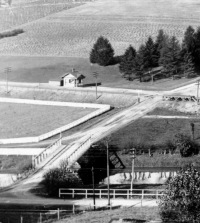
|
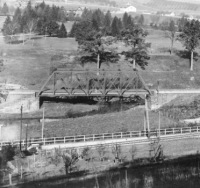
|
- These photographs by Force Dunlevy did not appear in
the print article. The tiny station and the freight
platform at Morganza are shown on the left. At right is
the railroad bridge after double-tracking. The
interurban trolley tracks in the foreground of both
pictures dates them as twentieth century.
|
The townspeople took great interest in the railroad and its
employees. An anniversary number of the Notes, in 1918,
exaggerated a bit when it related that "the whole town was accustomed
to go down to the station for the exciting pastime of ‘seeing the
train come in.’ Indeed Canonsburgers in those days had little else to
do, except to go to the post office, which they did every time a
train came in, and not infrequently between times."
From October 1877 until he was confined to his home by illness in
the fall of 1920, the Canonsburg depot was the responsibility of I.
B. Linn. "Once he was red-headed and hopeful;" the Notes
remarked in 1918, "today he is hopeful."
In the early days of the Chartiers Branch, the freight and ticket
agent was David R. Bebout and David Dunlop was the telegraph
operator. Mr. Linn was transferred from Washington to take over both
men’s jobs.
- "I. B. Linn Quits as Ticket
Agent at Canonsburg," Notes,
Feb. 10, 1921; "Long Service as Railway Agent," Notes, April 18, 1918. The 1921 article identified
Linn’s replacement as W. L. Jenkins.
The engineers and sometimes their locomotives also made the
papers. The Notes reported in 1891 that "Thomas Yates,
engineer of engine #54 on the Chartiers Valley Railroad," had
resigned from the railroad after 27 years to go into business in
Washington. The Notes reprinted this newsworthy item from a
Pittsburgh paper in 1897: "One of the heavy Class O modified engines,
No. 183, was sent out with the Washington Flyer on the Panhandle
Thursday. Engineer George McCabe needed some extra coaches to balance
the big machine, but he was not afraid to make the time."
- "Here, There and Elsewhere,"
Notes, March 28, 1891. Pittsburgh
Post, reprinted in "Local and County News,"
Canonsburg Herald,
Sept. 17, 1897. Washington Flyer is an unfamiliar name, but there were two express
trains from Washington to Pittsburgh in 1897. Number 118, the
Cannonball, left Washington at 8:00, arrived at Canonsburg
at 8:16, and Pittsburgh at 9:00. The afternoon express left
Washington at 12:50 and arrived at Union Station at 1:50. One
express went then other way. It left Pittsburgh at 5:10
(Pennsylvania Lines timetable, Notes,
April 9, 1897). The early afternoon express may have been the
Washington
Flyer. Note: the times
have been converted to local (Eastern Standard) time.
Class O was the Pennsylvania designation for a locomotive with a
4-4-0 wheel arrangement, also known as an American. We learn from
another Pittsburgh Post item reprinted in the Notes in
1902, "The old style class O engine No. 25 is now hauling the
Cannonball on the Chartiers and making the fast time without much
trouble." The newspaper informed the fashion conscious: "Pennsylvania
R.R. employees have put on their winter uniforms and caps. The new
caps are jet black, the same style as the white summer caps. The
uniforms are all double breasted."
New passenger coaches on the Chartiers Railway in 1885 were also
considered newsworthy. They were pronounced "exceedingly
comfortable," and even though it was August the reporter observed,
"They contain no stoves, the heating apparatus being placed under the
floor of the coach." Twenty years later the Notes said,
"Notice how the wooden freight cars are disappearing from the
Chartiers railroad. The wooden passenger coaches will follow, and
that in the near future."
- Untitled, Notes, March 4, 1901; "Donned New
Uniforms,"
Notes (wkly), Oct. 28,
1904; "Local Items," Rural Notes, Aug. 13, 1885; "Local Happenings,"
Daily
Notes, Oct. 8,
1913.
The Chartiers Railway was a branch of the Pittsburgh, Cincinnati
& St. Louis Railway Co., which was owned by the Pennsylvania
Railroad. In October 1890, the name was changed to Pittsburgh,
Cincinnati, Chicago & St. Louis, still the "Pan-Handle Route"
with the same officers.
- "Local Happenings,"
Notes, Oct. 4, 1890. The Pennsylvania
Railroad used both railroad and railway in the names of the companies it owned. In an
October 7, 1888 timetable, "Line" was used in the way "Division"
and "Branch" had been, to designate a part of the Pennsylvania
Railroad: "Pennsylvania Lines West of Pittsburgh." The subsidiary
operations were the Chicago, St. Louis & Pittsburgh
Railroad, Pittsburgh, Cincinnati $ St. Louis
Railway, Cincinnati & Muskingum Valley
Railway, Indianapolis & Vincennes
Railroad, and the Jeffersonville, Madison &
Indianapolis Railroad.
The railroad was a great benefit to farmers and stockmen
because of the obvious advantages of shipping animals on railroad
cars rather than having to drive them along roads. Another local
industry, coal mining, would not have been profitable if the railroad
had not expanded the market by providing a way to ship the coal
outside the local area. The first of what were called "railroad
mines," from their location adjacent to the railroad right-of-way,
went into operation in 1872. It was the Allison Mine, near McGovern,
run by Jonathan Allison. The mine was later sold to J. V. H. Cook
& Sons, of Canonsburg, who sold it in the late 1890s to the
Pittsburgh Coal Company.
- Joseph McFarland
20th Century History of the City of Washington and
Washington County Pennsylvania (Chicago, 1910), 295.
The largest coal operation in the Canonsburg vicinity was
the Pittsburgh & Buffalo Coal Company’s Hazel Mine, to the south
of the railroad in Canonsburg’s East End. It was a slope mine and
reached coal in October 1900, though such essentials as a power
house, tipple, and railroad sidings were unfinished. The formal
opening was July 1901. By 1904, production had increased to the point
where 100 coal cars, each with a capacity of 30 tons, were filled
daily. To handle the cars, the company bought its own switching
engine.
- Daily Notes, "Pittsburgh Buffalo Mine," Oct. 20,
1900; "Greatest in the World," July 5, 1901; "Freight Locomotive
for the Hazel Mines," Sept. 29, 1904.
- Figure 6 View of a train going
toward Pittsburgh. The large building is the milling
company, located where the Law and Finance Building
now stands. Illus. from Caldwell's Atlas of Wash. Co.,
1876.
|
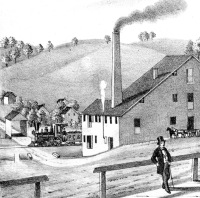
|
- Figure 6 Railroad coal cars at
the tipple of Pittsburgh & Buffalo Coal Company's
Hazel Mine, East Canonsburg.
|

|
|
Figure 7 The Canonsburg Iron &
Steel plant, better known by its later name, the Budke
Mill. Note the number of railroad sidings.
|
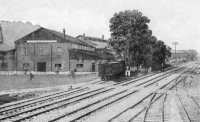
|
In 1880, long before the Hazel Mine went into operation,
the Notes observed that the Chartiers Valley Railway was
making money: $37,000 in 1878 and $24,700 in 1879. The profit margin
was quite high: the gross in 1878 was $84,487; in 1879, $84,660. The
newspaper’s editor, Fulton Philips, observed, "According to all this
the C V R R Stock ought to begin to be worth something." Freight
rates must have decreased during the period, as the gross income does
not reflect the marked increase in freight tonnage (110,250 tons in
1878 to 167,571 in 1879) and in passengers carried (126,714 to
130,743). The operating expenses were a great deal higher in 1879
($54,064 compared to $41,899), mostly attributable to
maintenance-of-way costs for improving the track bed and bridges.
- "Chartiers Railway,"
Rural
Notes, June 24,
1880.
It seems like the railroad considered passenger traffic
secondary to freight, as the Herald complained in 1882 that
one of the eastbound passenger trains (Washington to Pittsburgh) and
a westbound freight train passed in Canonsburg. Sometimes the
passenger train would be on the main track loading and discharging
passengers when the freight rolled up to station on the side track,
which was between the main track and the station platform.
The newspaper warned that somebody was going to be hit by the
freight engine pulling up to the station. If the freight train was
already at the platform, passengers had to scramble over or around it
to get to their train. Safety does not appear to have been a
prominent consideration for the railroad. It took six years, until
July 1878, for the railroad to begin installing warning posts at the
grade crossings along the Chartiers Division.
- Herald, "Dangerous," Oct. 13, 1882; "R.R.
Crossings," July 26, 1878.
It was more than ten years after the railroad’s arrival in
Canonsburg before it brought heavy industry to the town. In April
1882 two men, named Taylor and Mitchell, described by both Canonsburg
newspapers as "Pittsburgh iron men," representing the firm of Ewing,
Mitchell & Co., presented a proposition to a gathering of
Canonsburg’s influential citizens. Their company would put up
$100,000 to build a mill in or near Canonsburg to manufacture sheet
iron if the local citizens would raise an additional $50,000.
The building would be about 150 feet square and would
require 5 or 6 acres of land. A labor force of 200 men would be
needed. The location was desirable because of low taxes and the
availability of coal, of which about 1200 bushels a day would be
needed. The sheet iron that would be made is a type that at the time
was made in only three plants in this country, and there was a ready
market for the product for household utensils. It could be sold for 6
to 8 cents (presumably per pound). The cost of production would be 4
to 5 cents, and the Pennsylvania Railroad had guaranteed Pittsburgh
freight rates.
- "The Iron Mill,"
Rural
Notes, April 13, 1882;
"Iron Mill," Herald,
April 14, 1882.
The proposition had been put to the citizens of Washington,
who turned it down, but Canonsburg’s answer was strongly affirmative.
A Washington newspaper commented on that city’s turning down the
proposition, comparing it with Canonsburg’s loss of Jefferson
College. "Thus it will be seen, that pluck, courage and wisdom have
secured to Canonsburg an enterprise worth more to the thrift and
substantial prosperity of the place than half a dozen superbly
dressed colleges."
A company was organized with a local man, John Ewing, as
president. By mid-July, construction of the building was underway and
machinery had begun to be delivered. The railroad probably had
already constructed a spur into the plant property. The mill was only
a few hundred yards west of the depot, which would make it convenient
for workers to commute, a source of revenue for the railroad.
Operations began on New Years Day, 1883.
The iron mill drilled a well to supply gas for fuel and
illumination. In 1885, the railroad contracted with the mill to
provide the depot with gas for lights. The newspaper reported, "Jets
will be placed in the waiting rooms, telegraph office, ticket office,
ware room, and outside of the depot."
- Herald, "The Canonsburg Iron Mill," June 2,
1882, "The Iron Mill," July 14, 1882; "Plucky Canonsburg (from the
Washington Review)" Rural
Notes, May 18, 1882;
"Railroad Station," Herald,
May 8, 1885.
By Canonsburg’s centennial, in 1902, its two-thirds of a
century as a college town were ancient history. The town’s economy
was based on industry. Mills meant jobs, jobs meant workers, and
workers needed food, clothes, housing, entertainment and other goods
and services, which translated into more and more stores, shopping,
and money being made. In response to a complaint in another newspaper
about a "whistle nuisance," David Fee, editor of the Canonsburg
Rural Notes wrote:
If you really want to know something
about the "whistle nuisance," come to Canonsburg. About 4 o’clock in
the morning the Rolling mill commences a series of howlings that
arouses every living thing within five miles of the place. At 7
o’clock a protracted and unearthly howl from the Rolling mill, a
shrill scream from the woolen mill, a deep bellow from the Planing
mill, to which the two trains due at that minute keep time by their
roar, racket and yells. At 9 o’clock the freight returns from
Washington and spends the forenoon in "shifting" at this place. The
engineer of the freight seems to think that it would be a sin
unpardonable for him to move his engine the length of itself without
first giving utterance to a dozen war whoops shrill and piercing
enough to give a wooden Indian a headache.
But while the whistle is annoying, it is a sign of life. Would
rather have a hundred more whistles than the deadness, stillness and
eternal quiet that prevailed in this place a dozen years ago. Bring
on your factories and mills, we’ll put up with the whistle.
- "Notes and Comments,"
Rural
Notes, June 28,
1883.
By 1902, Canonsburg Steel & Iron had gone through a few
owners and the name had been changed, but there were 300 employees
and an output of 20,000 tons of sheet metal a year. Following the
iron mill to town had been Fort Pitt Bridge Works, which at the time
of the Centennial had a work force of 400 men and grossed a million
dollars. There was the Canonsburg China Company, which became
Canonsburg Pottery, 200 people who brought in $200,000 a year; Budke
Manufacturing with 50 employees; Alexander Manufacturing Co., 30
workmen; Simpson Stove & Manufacturing Co., 100 people. The
Pittsburgh & Buffalo Coal Company, East End, employed 450 men at
its Hazel Mine and shipped 35 to 40 cars of coal a day. Pittsburgh
Coal Company’s Boone Mine, in what is now Strabane, also shipped lots
of coal. At the time of the Centennial, Standard Tin Plate was not
yet in production, but was expected to employ 300 to 400 men in the
near future.
Another article that Centennial year claimed the Chartiers Branch
was the "best paying road in all the world." Though, in the spirit of
that year’s celebration, the claim might have been an exaggeration.
The article states that the railroad, just 32 miles long, carried an
average of 4500 passengers a day. For a circus or a parade, the
railroad could be expected to haul 10,000 people to Pittsburgh. The
revenue from passengers and freight was estimated at three million
dollars a year.
The watchman at the Central Avenue railroad crossing, Ernest
Smith, reported that 115 trains—"passenger, coal and shifting
trains"—had crossed on a Thursday in April 1902. Pike Street in East
End was crossed 61 times that day. There were 12 trains daily, 9 of
which went all the way between Washington and Pittsburgh. Two of
these, one each way, were Cannonball express runs, which made
an average speed of 32 miles per hour. There were just two scheduled
runs on Sundays.
- "Railroad Business Shows
Canonsburg’s Great Growth," Notes,
Sept. 26, 1902; "Best Paying Road in All the World (reprinted from
the Pittsburgh Sunday
Leader),"
Notes, Dec. 1, 1902; "Local Happenings,"
Notes, April 18, 1902.
The first trains on the railroad had been mixed passenger
and freight, subject to delay for unloading. Then came separate
passenger and freight trains. This provided much better service, but
as early as 1882, the Rural Notes had an express on its
Christmas list: "Very heavy travel on the C.V.R.R. We need an express
train. We’re all in a hurry out here and want to ‘fly’ when we
travel. Hope the railroad company will give us that express train—it
will be crowded every day."
The railroad did not oblige, and the following year the newspaper
complained: "A fast train is needed on the Chartiers Railroad. It is
only about 23 miles from here to the city, and yet in that short
distance the train makes 24 stops. A train that will make not more
than 4 or 5 stops from Washington to Pittsburg is what we want."
- Rural Notes,
Untitled, Dec. 21,
1882; "Our Telescope," Oct. 25, 1883. The Notes’ editor, David H. Fee, spelled Pittsburgh without the "h" but he tacked it on the end of
Canonsburg
in his newspaper’s
masthead.
|
Figure 8 Watchman Ernest Smith at the
Central Avenue railroad crossing. The mill race, behind him,
has not yet been filled in.
|
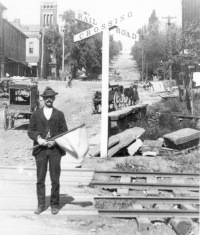
|
The railroad did put on an express between Washington and
Pittsburgh in July 1889 that stopped only at Canonsburg and
Bridgeville. The morning train, #118, left Washington at 8:45 (local
time), was scheduled to depart Canonsburg at 8:58, Bridgeville at
9:14 and arrive at Pittsburgh at 9:40. It was known as the
Cannonball. Before this, the fast train to Pittsburgh, #122,
had left Washington at 7:30, with scheduled stops at Canonsburg,
Bridgeville, and Mansfield, and arrived at Pittsburgh at 8:50.
However, it would make flag stops at Meadowlands, Morganza, and
Woodville.
- "Time Tables," Herald, July 17 and 24, 1889; "Pennsylvania Lines West
of Pittsburgh" Time Table, Oct. 7, 1888. The July 24, 1889
timetable in the Herald
is the first to show the Cannonballs (#118, to Pittsburgh and #117 from Pittsburgh),
probably because of a delay by the railroad in preparing it. The
revised timetable is marked, "Corrected to July 8th, 1889."
The Cannonball was the fastest train on the
Chartiers; too fast for Canonsburg’s councilmen. In 1893, the borough
council enacted an ordinance that limited the speed of trains within
the borough to 8 miles per hour. The railroad protested, but the
borough council stood firm. In retaliation, the Canonsburg stop was
removed from the Cannonball’s schedule.
The timetable published in the newspaper on December 20, 1893
shows no intermediate stops between Washington and Pittsburgh, which
means that Bridgeville was bypassed as well. Also, the times were
changed: #118 departed Washington at 8 a.m. rather than 8:45, and
#117 left Pittsburgh at 5:13 rather than 5:45 (local times). Other
trains took about an hour and a half for the trip, but the early
morning train (probably mixed freight and passenger cars) left
Washington at 5:55 but was not scheduled to arrive in Pittsburgh for
nearly two hours.
On December 4, a representative of the railroad met with council
and proposed that the railroad would place a watchman at the
intersection of council’s choice and the train would again stop if
Canonsburg would raise the speed limit to 20 miles per hour. The
newspaper notes, "The cannonball matter was then called up for
consideration and warmly discussed."
At the council meeting the following week, a letter was read from
Superintendent Turner of the P.C.C.& St.L. Railroad. He
reiterated that the train would stop if council raised the speed
limit to 20 mph. This was not what council wanted to hear. An answer
was crafted "stating that if the railroad company would place a
watchman at the mill crossing [present Iron Street] and one at the
East Pike street crossing from the hours of 7 a.m. to 7 p.m., and
stop all passenger trains at the Canonsburg depot, council will
change the speed ordinance from 8 to 20 miles and hour."
Christmas 1893 came and went, as did the early months of 1894,
and still the Cannonball steamed through without stopping.
Finally, council rescinded the ordinance, and the May 20, 1894
timetable shows that #117 and #118 were again stopping at Canonsburg
and Bridgeville, but the trains continued to leave Washington at 8
a.m. and Pittsburgh at 5:13.
- Herald, timetables Nov. 29 and Dec. 20, 1893;
"Council Proceedings," Dec. 6 and 13, 1893, June 20, 1894;
"Yesterdays in Canonsburg," Notes,
April 18, 1919; The Pennsylvania Lines: Pan-Handle Route Time
Tables, Nov. 19, 1893. The Notes
file is missing from the microfilm for this period. Times have
been converted to Eastern Standard Time.
It is hard to comprehend, considering the roadbed of today,
but in 1904 the Cannonball was timed from Boyce to Canonsburg:
eight miles in eight minutes. That is sixty miles an hour. If it
followed the schedule, it had left Pittsburgh as #161 at 5:10 in the
afternoon, due at Canonsburg at 5:50 and at Washington at 6:06.
- "Local Happenings,"
Notes, June 3, 1904; "Changes on the Chartiers
Road," Notes,
May 13, 1904. The morning Cannonball was scheduled to leave Washington at 8 a.m.,
arrive at Canonsburg at 8:16 and pull into Union Depot, Pittsburgh
at 8:55.
The Cannonball was the best known, but there were other
named trains (formally or informally) on the Chartiers. The
Owl or Bummer departed Pittsburgh late at night (11:30
p.m. in 1901, 11:15 for a while, then it was returned to 11:30). The
Pittsburgh Post reported that the Washington-bound train was
"very popular with the night patrons of the road and carries hundreds
of passengers." So much for everybody going to bed with the chickens
in those days long ago.
- "Time of Trains at
Canonsburg,"
Notes, April 9, 1901;
"’Bummer’ to Run on its Old Schedule," Notes,
May 22, 1914.
The amount of traffic had increased to such an extent by
1902 that, despite the sidings, the single track was not sufficient.
The answer was to double-track at least the most congested part of
the Chartiers division, that around Canonsburg. Rather than doing the
construction itself, the Pennsylvania Railroad contracted with
Columbia Construction Company of Pittsburgh to lay the second track
between Boyce and Houston. For the work, the company brought in some
one hundred Italian laborers. To house them, a barn and shanties on
the Alexander farm (present-day Strabane) were adapted for winter
living. To the local people, most of whom claimed Ireland, Scotland,
or England as their ancestral home, these men from the Mediterranean
were exotic curiosities.
- "Railroad Contractors in
Town," Notes,
Nov. 25, 1902.
In an article, "The Industrious Italian," the Canonsburg
Notes provided a glimpse of both the immigrants and the
locals’ reaction to them.
These men live in shacks, and having no
family relations to control them, are free from restraints, which to
many men is construed as license. Their environment is not pleasant.
Their work is hard and they do an honest days’ work. Such is remarked
by all. Their food is plain and not over enticing, but these men have
been the most orderly set of men our town ever had to deal with. Not
one arrest has been made. No drunkenness on our streets has been
noticed in any of them. They are paid regularly and no disturbance is
caused. They pay their bills and too often are imposed on and
overcharged.
The Irish, who built the railroads 25 or 30 years ago, were the
best class of laborers this country ever had, but even they would
have a bit of a shindig with a few broken heads on payday. But the
Irish have graduated. They now represent us in council and as
burgess, etc. . . . Who knows but the descendents of these despised
ditch diggers will be the future office holders of this country?
- "The Industrious Italian,"
Notes, Dec. 3, 1902.
Toward the middle of
December 1902, work began on the second track at what is now
Strabane. Small locomotives ("dinky engines"), cars and steam shovels
had been brought on freight cars to a siding near the station. As
soon as a temporary second track was laid on the side away from
Strabane, the equipment was taken the short distance and unloaded.
Work went on through that winter and the following, and by March 1904
the line was double-tracked from Carnegie to Houston. Completion was
held up until a new bridge was built at Morganza and some work done
at Bell’s Tunnel."
- "Grading for Double Track,"
Notes, Dec. 9, 1902; "Double Track is About
Completed,"
Notes, March 18, 1904.
A second track had been laid down between Glendale and Bridgeville
in 1901 using 85-pound rail ("Great Work on Chartiers,"
Herald, April 9, 1901).
The new double track experienced a novelty in May 1904 when
the Chartiers Division tracks carried a number of B&O trains. A
wreck on the B&O east of Washington blocked that railroad’s
right-of-way, so the P.C.& St.L. allowed the foreign trains to
travel its track from Pittsburgh to Washington.
"B.&O. Train Over the
Chartiers," Notes, May
6, 1904.
|
Figure 9 These views looking west
along the tracks toward Central Avenue, were taken after
the railroad was double-tracked.
|

|
Now the passenger trains are gone, as has most of the industrial
output that was carried on freight trains. For that matter, the
Pennsylvania Railroad is extinct. About two years ago the second
track was torn up and the railroad is back to one track. But at least
there still are trains, though no cabooses, on the Pittsburgh
Industrial Railroad, ready for Canonsburg’s next metamorphosis.
- The last scheduled passenger
train through Canonsburg made its final stop at 6:27 p.m. on July
30, 1952. It was pulled by a big K-4 steam locomotive, #3489, that
with its tender was nearly too long for the turntable at
Washington ("81 Years of PRR Service Is Ended," Daily Notes, July 31, 1952).
- Figure 10 This photograph was
taken in October 1999, facing east from Central Avenue.
The second track is gone, except where it is used as a
siding.
|
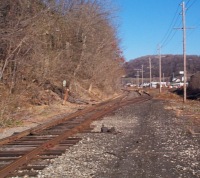
|
- Figure 10a. The switch mechanism
at the siding carries the date, 1904.
|
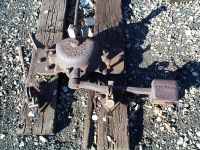
|



